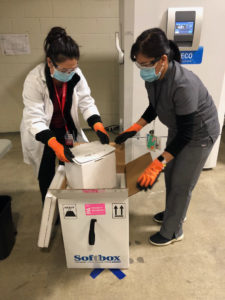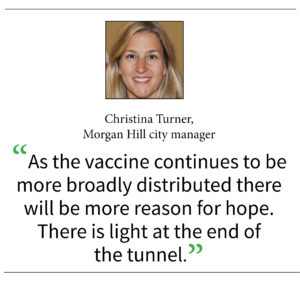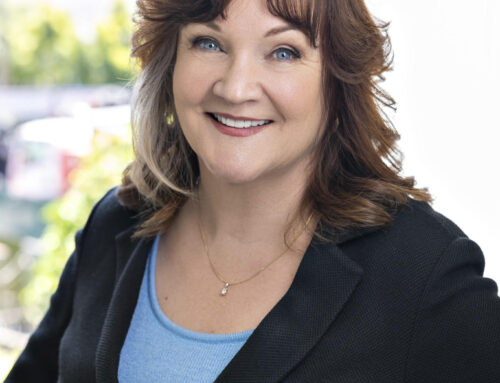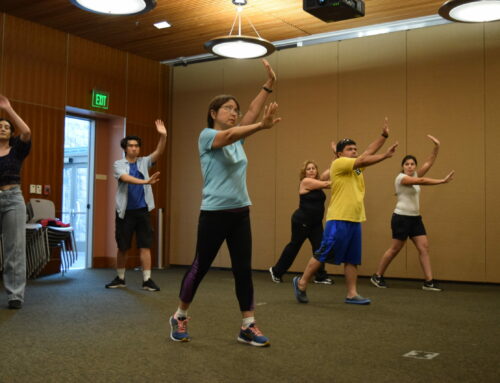Experts say strain on ICUs will lift significantly in the coming weeks

By Marty Cheek and Robert Airoldi
Two weeks after Gov. Gavin Newsom lifted the stay-at-home order for all regions across California, Santa Clara County has seen a decrease in new cases and hospitalizations. The county reported a seven-day average of 549.1 new cases per day, a 56.5 percent decrease from two weeks ago.
Immediately after Newsom’s announcement, Santa Clara County began allowing outdoor dining, personal care services, and professional, collegiate and adult and youth sports to resume with required modifications.
As of Friday Feb. 5, Morgan Hill has 3,122 residents listed as confirmed cases of the virus, while Gilroy has had 6,806 residents (nearly 13 percent of the city) listed as confirmed cases. Medical staff, including at St. Louise Regional Hospital, continue to be stretched. Through the month of January, new daily confirmed county cases continue to be much higher than the previous summer peak.
Despite the state opening its restrictions, the danger the coronavirus poses to the public has not subsided, emphasized Santa Clara County Health Officer and Director of Public Health for the county Dr. Sara Cody. She urges businesses, entities, and residents to continue exercising caution even as certain restrictions are lifted by the state.
 The purple tier (widespread risk) of the state’s Blueprint for a Safer Economy opens the economy locally with some additional local restrictions remaining in place including the county’s mandatory travel restriction requiring a 10-day quarantine for most people who travel into the county from more than 150 miles away.
The purple tier (widespread risk) of the state’s Blueprint for a Safer Economy opens the economy locally with some additional local restrictions remaining in place including the county’s mandatory travel restriction requiring a 10-day quarantine for most people who travel into the county from more than 150 miles away.
“Santa Clara County continues to experience very high rates of COVID-19 transmission,” Cody said in a Jan. 25 press release. “Our collective actions to date have saved lives and helped protect our healthcare system from collapse. I encourage all residents to remain vigilant, wear a mask anytime you leave your home, maintain a distance of at least six feet from anyone outside your household, and get vaccinated when it is your turn.”
Going back to the purple tier is a lifeline for many businesses that are holding on by a thread, said Christina Turner, city manager for Morgan Hill.
 “The back and forth of opening and closing indoors and outdoors has been extremely difficult,” she said.
“The back and forth of opening and closing indoors and outdoors has been extremely difficult,” she said.
She encourages members of the South Valley community to continue to remain vigilant and stay indoors as much as possible to reduce the potential spread of COVID-19. She also encourages everyone to wear a mask, maintain physical distance and not gather indoors.
“As the vaccine continues to be more broadly distributed, there will be more reason for hope,” she said. “There is a light at the end of the tunnel.”
 Most businesses that are allowed to open indoor operations to the public must limit capacity of their publicly accessible space to 20 percent. The county’s mandatory directive on capacity limitations has been updated to reflect current openings and closings.
Most businesses that are allowed to open indoor operations to the public must limit capacity of their publicly accessible space to 20 percent. The county’s mandatory directive on capacity limitations has been updated to reflect current openings and closings.
Outdoor gatherings with up to three households are now allowed for any purpose. Larger outdoor gatherings with up to 200 people are allowed only for political, religious, or ceremonial purposes, or as otherwise specifically allowed by the state. Indoor gatherings of any kind remain prohibited.
The county’s mandatory directive on travel, which requires most people who travel into the county from more than 150 miles away to quarantine for 10 days upon their arrival, is still in effect.
The county’s mandatory directive for lodging facilities is still in effect. Lodging facilities may not provide lodging services for non-essential purposes, such as tourism, recreational, or leisure purposes. Non-essential travel should be avoided, especially in light of new variants of COVID-19 that are circulating globally and in the United States.
The reversal by state public health officials of the stay-at-home orders was abrupt, prompting accusations by critics that Newsom made the decision based on politics over medical science. The rates of COVID-19 cases still remain high in the aftermath of the holidays.
Newsom defended the decision to open the state by saying models showed the strain on ICUs at hospitals will be lifting significantly in the next several weeks.
By Feb. 21, ICU capacity is projected to reach 30.3 percent across California, with 33.3 percent of space available in Southern California, 22.3 percent in the San Joaquin Valley and 25 percent in the Bay Area.
In other COVID-19 news, Santa Clara County Jan. 26 expanded vaccination to residents 65 and older.
“As the vaccine becomes available to more residents, the county continues its commitment to equity and ensuring access for our communities most at risk of contracting COVID-19,” said Dr. Jennifer Tong, Associate Chief Medical Officer for the County of Santa Clara Health System.






